|
Battle of Berryville, Virginia
Battle of Berryville
Other Names: None
Location: Clarke County, Virginia
Campaign: Sheridan's Shenandoah Valley Campaign (August-October 1864)
Date(s): September
3-4, 1864
Principal Commanders: Maj. Gen. Philip Sheridan [US]; Lt. Gen.
Jubal Early [CS]
Forces Engaged: Corps
Estimated Casualties: 500 total
Result(s): Inconclusive
Description: Maj. Gen. Philip Sheridan’s divisions marched
south from Halltown, reaching Berryville on September 3. Happening upon elements of Brig. Gen. George Crook’s corps
going into camp, Maj. Gen. R.H. Anderson’s (Kershaw’s) division attacked with limited results. During the night,
Early brought up his entire army but by daylight found Sheridan’s position too strongly entrenched to assault. General
Early withdrew after dark behind Opequon Creek.
| Battle of Berryville, Virginia, Map |
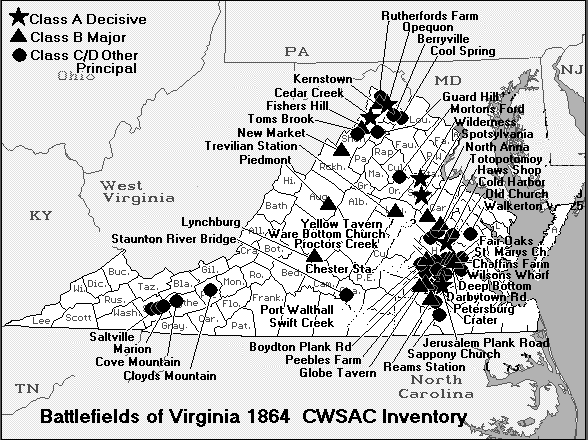
|
| Civil War Berryville Battlefield Map |
| Battle of Berryville Civil War Map |
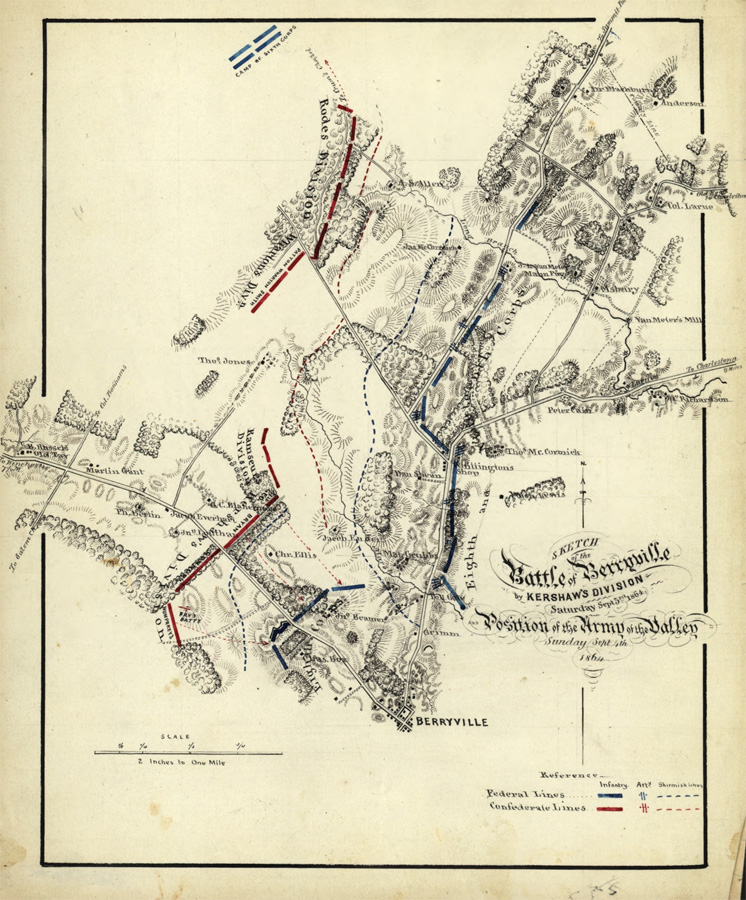
|
| Berryville Battlefield Map |
| Clarke County, Virginia, Map |
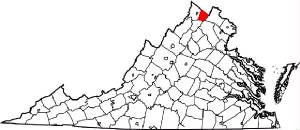
|
| Battle of Berryville, Virginia |
Grant finally lost patience
with Early, particularly his burning of Chambersburg, and knew that Washington remained vulnerable if Early was still on the
loose. He found a new commander aggressive enough to defeat Early: Philip Sheridan, the cavalry commander of the Army of the
Potomac, who was given command of all forces in the area, calling them the Army of the Shenandoah.
Sheridan initially started slowly, primarily because the impending
presidential election of 1864 demanded a cautious approach, avoiding any disaster that might lead to the defeat of Abraham
Lincoln.
Battle: The Battle of Berryville was fought September 3
and September 4, 1864, in Clarke County, Virginia. It was fought toward the end of the American Civil War.
After taking control of Smithfield Summit on August 29, Union Maj. Gen.
Philip H. Sheridan marched to Berryville with his 50,000 man Army of the Shenandoah. At the same time Confederate Lt. Gen.
Jubal A. Early sent Maj. Gen. Joseph B. Kershaw's division east from Winchester to Berryville. At about 5:00 p.m., Kershaw
attacked Colonel Joseph Thoburn's division of the VIII Corps while they were preparing to go into camp. Kershaw routed Thoburn's
left flank before the rest of the corps came to the rescue. Darkness ended the fighting, with both sides bringing in heavy
reinforcements. The next morning, Early, seeing the strength of the Union's entrenched line, retreated behind Opequon Creek
(Winchester).
| Battle of Berryville |
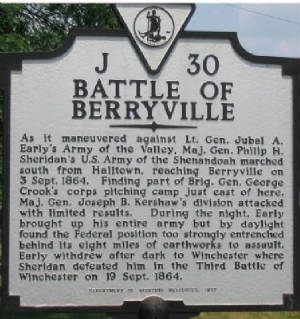
|
| Civil War Battle of Berryville |
(Right) Historical Marker: As it maneuvered against
Lt. Gen. Jubal A. Early’s Army of the Valley, Maj. Gen. Philip H. Sheridan’s U.S. Army of the Shenandoah marched
south from Halltown, reaching Berryville on September 3, 1864. Finding part of Brig. Gen. George Crook’s corps pitching
camp just east of here, Maj. Gen. Joseph B. Kershaw’s division attacked with limited results. During the night, Early
brought up his entire army but by daylight found the Federal position too strongly entrenched behind its eight miles of earthworks
to assault. Early withdrew after dark to Winchester where Sheridan defeated him in the Third Battle of Winchester on September
19, 1864.
Aftermath and Analysis: Completing his missions of
neutralizing Early and suppressing the Valley's military-related economy, Sheridan returned to assist Grant at the Richmond-Petersburg Campaign. Most of the men of Early's corps rejoined Lee at Petersburg in December, while Early remained to command a skeleton force. His final action
was defeat at the Battle of Waynesboro on March 2, 1865, after which Lee removed him from his command because the Confederate
government and people had lost confidence in him. (Shenandoah Valley and the American Civil War and American Civil War in the Shenandoah Valley.)
Clarke County, during the Civil War, was known for its large wheat crops and it served as a Union supply
route in the Shenandoah Valley.
During the Civil War, John S. Mosby, "the Gray Ghost" of the Confederacy, raided General Sheridan's supply
train in the summer of 1864, in Berryville. The Battle of Cool Spring was fought in Clarke County on July 17 and 18th, 1864,
and the Battle of Berryville on September 3, 1864.
Berryville History: Berryville
is the county seat for Clarke County, Virginia, and is located in the upper Shenandoah Valley, approximately 12
miles (19 km) east of Winchester and 11 miles (18 km) south of the West Virginia border.
Berryville was founded at the intersection of the Winchester Turnpike and
Charlestown Road. The land was first granted by the Crown to Captain Isaac Pennington in 1734, and George Washington surveyed
it on October 23, 1750. In 1754 Pennington sold it to Colonel John Hite.
According to legend, Daniel Morgan would engage in combat with young toughs
at the intersection, having first piled large stones nearby to use as ammunition in case of need. Because of this story, and
a rowdy tavern nearby, the area was first given the informal name of "Battle Town".
| Civil War Berryville Historical Battlefield Map |
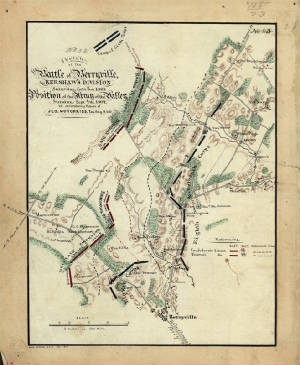
|
| Battle of Berryville History Map |
Hite sold the tract in 1765 to his son-in-law, Major Charles Smith. Smith
also named his estate "Battle Town", and on the site of the former tavern he built a clapboard homestead, which still stands
on Main Street and is now known as "the Nook".
Daniel Morgan returned to the area after distinguishing himself in the Revolution,
living at Saratoga, and briefly at Soldier's Rest. He was one of the frequent (and reputedly most quarrelsome) patrons of
the new tavern (where now stands the Battletown Inn).
Major Smith's son, John Smith, in 1797 sold 20 acres (81,000 m2) of his
inheritance to Benjamin Berry and Sarah (Berry) Stribling, who divided it into lots for a town. It was established as the
town of Berryville on January 15, 1798. By 1810, the town had at
least 25 homes, three stores, an apothecary (pharmacy), two taverns, and an academy (school). It was not much larger when
it became the county seat of newly-formed Clarke County in 1836.
Confederate Gen. Jubal A. Early briefly had his headquarters in the town,
and not long afterward the Battle of Berryville was fought in and around the town during the Valley Campaigns of 1864, during
the American Civil War. The railroad arrived in the 1870s.
(Sources listed below.)
Sources: National Park Service; Library of Congress; Official
Records of the Union and Confederate Armies; Gallagher, Gary W., ed. Struggle for the Shenandoah: Essays on the 1864 Valley
Campaign. Kent, OH: Kent State University Press, 1991. ISBN 0-87338-429-6; Patchan, Scott C. Shenandoah Summer: The 1864 Valley
Campaign. Lincoln: University of Nebraska Press, 2007. ISBN 978-0-8032-3754-4; Cooling, Benjamin Franklin. Jubal Early's Raid
on Washington, 1864. Baltimore: Nautical & Aviation Publishing Company of America, 1989. ISBN 0-933852-86-X; Early, Jubal
A., "General Jubal A. Early tells his story of his advance upon Washington, D.C.". Washington National Republican, 1864; Early,
Jubal A. A Memoir of the Last Year of the War for Independence in the Confederate States of America. Edited by Gary W. Gallagher.
Columbia: University of South Carolina Press, 2001. ISBN 1-57003-450-8; Gallagher, Gary W., ed. The Shenandoah Valley Campaign
of 1864. Military Campaigns of the Civil War. Chapel Hill: University of North Carolina Press, 2006. ISBN 978-0-8078-3005-5;
Lewis, Thomas A., and the Editors of Time-Life Books. The Shenandoah in Flames: The Valley Campaign of 1864. Alexandria, VA:
Time-Life Books, 1987. ISBN 0-8094-4784-3; Mary Gray Farland, 1978, In the Shadow of the Blue Ridge, 158; Carrie Hunter Willis
and Etta Belle Walker, 1937, Legends of the Skyline Drive and the Great Valley of Virginia, 26.
|

